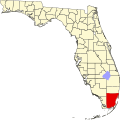2020 census
As of the 2020 United States census, there were 32,499 people, 10,072 households, and 6,892 families residing in the CDP. [13]
As of the 2010 United States census, there were 33,145 people, 9,320 households, and 6,992 families residing in the CDP. [14]
2000 census
As of the census of 2000, there were 32,623 people, 9,826 households, and 7,281 families residing in the CDP. The population density was 2,560.1/km² (6,635.0/mi²). There were 10,540 housing units at an average density of 827.1/km² (2,143.7/mi²). The racial makeup of the CDP was 23.38% White (12.1% Non-Hispanic White), [15] 65.29% African American, 0.28% Native American, 1.81% Asian, 0.07% Pacific Islander, 2.92% from other races, and 6.24% from two or more races. Hispanic or Latino of any race were 17.63% of the population.
As of 2000, there were 9,826 households out of which 44.5% had children under the age of 18 living with them, 41.8% were married couples living together, 24.5% had a female householder with no husband present, and 25.9% were non-families. 20.6% of all households were made up of individuals and 7.3% had someone living alone who was 65 years of age or older. The average household size was 3.23 and the average family size was 3.72.
In 2000, in the CDP, the population was spread out with 31.1% under the age of 18, 10.2% from 18 to 24, 30.1% from 25 to 44, 18.5% from 45 to 64, and 10.1% who were 65 years of age or older. The median age was 31 years. For every 100 females there were 89.2 males. For every 100 females age 18 and over, there were 83.8 males.
In 2000, the median income for a household in the CDP was $30,841, and the median income for a family was $33,577. Males had a median income of $25,036 versus $21,409 for females. The per capita income for the CDP was $12,341. About 18.5% of families and 20.9% of the population were below the poverty line, including 25.4% of those under age 18 and 24.0% of those age 65 or over.
As of 2000, speakers of English as a first language accounted for 44.27% of residents, while French Creole made up 31.35%, Spanish was at 18.63%, and French was at 3.82% of the population. [16]
As of 2000, Biscayne Gardens had the highest percentage of Haitian residents in the US, with 33.50% of the populace (nearby North Miami had the second highest percentage in the US, with 33.0% of the populace.) [17] It had the fourth highest percentage of Bahamian residents in the US, at 1.80% of the population, [18] and the twentieth highest percentage of Jamaican residents in the US, at 5.70% (tied with Ives Estates, FL, East Orange, New Jersey and Gordon Heights, New York.) [19] It also had the seventy-eighth most Cubans in the US, at 4.04% of the population, [20] while it had the ninety-first highest percentage of Dominicans, at 1.72% of all residents (tied with North Miami and East Newark, New Jersey.) [21]



